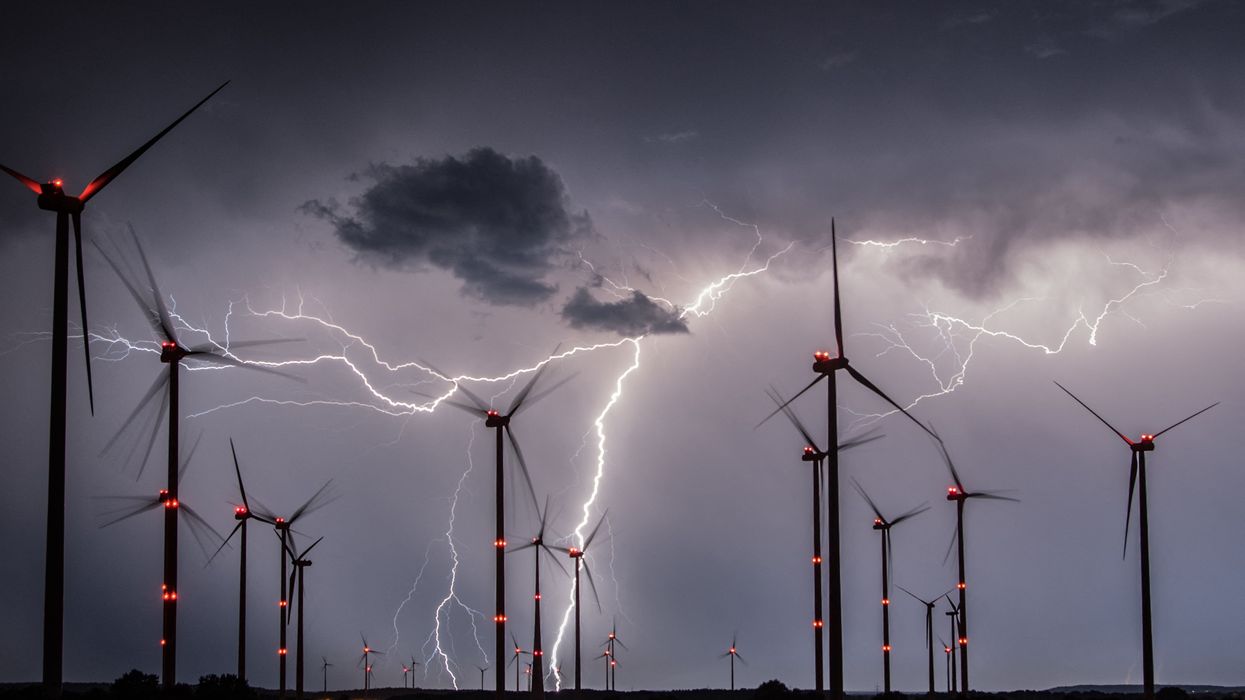
PATRICK PLEUL via Getty Images

There is a need to minimize the negative impact we have on our planet. However, our adoption of recent green technologies in the pursuit of minimizing environmental damage has already led to unforeseen and all-too-unmentioned ecological destruction. Is this just the price we have to pay?
Note: This article originally appeared in the print edition of Return.
From the position of the archaeologist, technology is a neutral term. From flint hand-axes to sickles, antler harpoons to fish traps, the earliest forms of technology leverage efficiency and capability at the interface between the human and the rest of the world. There is nothing unnatural about this – crows, otters, monkeys, even crocodiles make use of manipulated objects to exploit their dietary niche. Where there are concerns about how modern technology functions, they shouldn’t be framed as a dichotomy between “good” and “bad” but rather aimed at the specific problems created. Too often what counts for academia today will position any discussion of technology in a framework of “neoliberalism” and “systems thinking.”
The question before us is: Do we tear up a unique and important ocean ecosystem in order to fuel the Green Revolution?
Some will talk of the Anthropocene, barely suppressing their glee at the control such definitions bring. What I want to do here is outline some concrete and non-systemic threats that specific technologies pose. It is my contention that only through approaching risks to the natural world in this way will we actually retain the ability to tackle them. Beyond the nebulous outlines of international agreements and porous commitments lies the bulwark of the nation-state and its capacities. Let us not be shy in demanding it makes use of them.
The new Green Revolution and its consequences are rolling like a tidal wave across the world. One of its most insidious children is the “net-zero” mining industry. To be absolutely clear, the new eco-friendly techno-complex of electric cars, wind- and solar-generated energy, and the vast new infrastructure of batteries needed to support these relies precariously on this industry’s ability to extract unprecedented amounts of raw minerals. According to the World Bank’s 2020 report Minerals for Climate Action, the increase in mineral production includes a staggering 488% increase in demand for lithium, 460% for cobalt, 231% for indium, and a 189% increase for vanadium.
The projections for the U.K. to meet its target for electric cars would require the world’s current output of neodymium, almost twice the world’s production of cobalt, and three-quarters of the global lithium production. With two of the main countries for nickel, cobalt, manganese, and copper being China and the Democratic Republic of Congo, the race has started to find alternative mining venues. European nickel mines are one option, but by far the most enticing is the prospect of undersea mining.
Back in the deepest past, earth’s seawater began to slowly precipitate heavy metals. Manganese and iron oxyhydroxides began to scavenge cations of cobalt, copper, and nickel, freed by the actions of undersea hydrothermal vents and the imperceptible metabolism of microorganisms, and they settled over millions of years into polymetallic nodules. But why is this important?
These nodules lie scattered all over the sea floor, most no larger than a duck’s egg, a gift from Mother Nature to a civilization desperate for metals. The Clipperton Fracture Zone, 4.5 million square kilometers rich in manganese nodules, is just one prime example of the embarrassment of riches lying untapped and unused. The world has just realized that these treasure troves now need to be harvested, and companies are applying for exploratory licenses everywhere from Nauru to Mexico. Specialized sea craft with submarine vehicles now pioneer the extraction of nodules, suctioning, grinding, harvesting, and crushing the metals before sending them up to the surface. “What’s the problem?” I hear you ask. “Surely we need this?”
The problem is that these nodules are not sterile globules of free resources, like some computer-game world. They are in fact the underpinning keystone in a complex food web that we barely glimpse through the handful of studies that have focused on them. What we do know is this: The nodules themselves are coated with living beings, and one in particular, the stalked glass sponge, is considered a key structural species. The trophic webs that exist in these deep abyssal zones rely on the nodules as the only physical structural support to anchor onto, the soft sediment being incapable of supporting these species.
The cascading effects of removing the nodules flow upward to the sediment and filter feeders, the scavengers, omnivores, and carnivores. Equally as devastating are the fine sediment plumes created by the harvesters and the waste dumping after extraction. These clouds smother species to death and choke up life on the precarious reefs. Added to these known factors are the unknown risks. A 2016 study of the Clipperton Fracture Zone found that half of all the collected species were new to science. More dangerous (and ironic) is the possibility that deposits of frozen methane, known as methane clathrates, could be accidentally disturbed, potentially releasing unknown quantities of natural gas into the ocean and the atmosphere.
The question before us is: Do we tear up a unique and important ocean ecosystem in order to fuel the Green Revolution? The cost-benefit analysis here should look at what this revolution actually offers and whether it is desirable. It seems unlikely that all the ocean’s metals are going to remain unused, and no amount of international pressure will stop a country like China from exploiting its own shoreline. But we needn’t all rush onward with the charge for an electric battery-powered world. There are alternatives.

On a list of conversational topics bound to cure insomnia, sand has to be near the top. Yet this basic and seemingly ubiquitous material is rapidly becoming a coveted resource. How is this possible? Sand is required for a number of fundamental industries, including construction, road building, electronics, plastics, cosmetics, detergents, and water filtration. Regrettably, it is also essential for the production of solar panels, something that gets very little mention. Due to the nature of the grains, desert sand is practically worthless, being too fine to bind together. This makes rivers, lakes, and any accessible ocean the major targets for sand extraction and mining. On the face of it, this sounds reasonable. However, we have two huge problems here — firstly, the amount of available sand in the world is shrinking faster than it can be replenished; secondly, the damage caused to the environment, ecology, and human habitation around the mined areas.
Sand extraction accounts for 85% of all mineral production globally by weight. Roughly 32 to 50 billion tons of sand are used annually, which, according to some models, will lead to demand outstripping supply before the century is out. Virtually every country imports sand, with the leading exporters, such as China and the United States, shipping 300 million tons in 2019. These figures are notoriously unreliable, however, since, as we’ll see later on, the illegal mining of sand is likely the largest supplier. As an example, between 2006 and 2016, Singapore imported 80 million tons of sand from Cambodia, but only 4% of that was through legal export channels. Since Singapore desperately needs sand for land reclamation and skyscraper building, the nearby countries have scoured billions of tons of sand for illegal export, so much so that Indonesia has physically lost over 20 islands and another 80 are at risk.
Ecologically, sand mining at scale presents a number of problems: It lowers water tables, depletes wells, physically destroys habitats, alters the shape and flow of rivers, disrupts food webs, creates riverbank instability, collapses bridges, changes the velocity of the river flow, which can cause flooding and damage to property, and leaches salt into agricultural land. Dune removal can cause flooding, dust plumes can increase airborne radioactivity and damage health, and so on. The standard method for sand extraction is to dredge, at different scales and in a number of different ways. Ranging from Nigerians physically wading into the surf and carrying baskets of sand away on their heads and Tamil truck drivers parking on tourist beaches and filling up using spades to huge Chinese commercial ships complete with conveyor belts and barges, the nature of the work depends on the country and its legality. At the risk of repeating previous talking points, sand mining clearly has an immediate and long-term impact on the ecology of the region. The physical removal of beaches, dunes, sandbanks, and riverbeds negates the ability of dependent wildlife and flora to survive, but another consequence is the spillover into violence in the human world.
Illegal sand mining seems like one of those minor headline topics, but the scale of the organization goes far beyond what most people understand. Unauthorized sand extraction is the largest criminal enterprise in India, in particular the southern state of Tamil Nadu. In China, the Yangtze River has been a target for illegal extraction for decades, since the state banned mining in 2000. In 2019 alone police seized over 300 vessels carrying approximately 100 million cubic feet of sand. Yet the theft continues, in part due to sophisticated GPS spoofing, which prevents authorities from accurately monitoring ship movement in real time, resulting in lethal collisions.
Thane Creek, the river inlet from the Arabian Sea to Mumbai, swarms with hundreds of small wooden boats, all illegally scooping up sand from the riverbed by hand. The divers used to make the plunge down to 20 feet. A few years later they are at their physical limits of 40 feet. Soon the riverbed will simply disappear. Like many similar illegal mines and dredge sites in India, they are run by mafias with the power to buy off local officials and murder journalists and protesters. On the larger geopolitical level, the tensions between Singapore and Indonesia/Malaysia have reached the point where the Indonesian navy has been deployed to arrest illegal sand miners in its territory.
Stone Age Herbalist